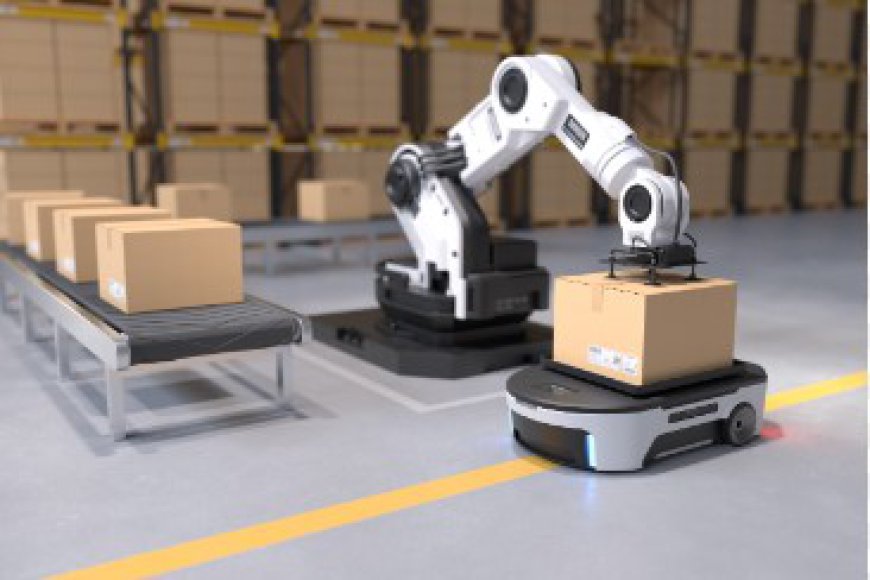The Role of Robotics in Modern Material Handling Systems

It is a critical aspect of any industrial operation, encompassing the movement, protection, storage, and control of materials throughout the manufacturing, distribution, and disposal stages. As industries evolve and demands for efficiency and productivity increase, the adoption of robotics in material handling systems has become a game-changer. From warehouses to production lines, robots are transforming the way materials are handled, leading to unprecedented levels of automation, accuracy, and safety.
From Manual Labor to Automation: The Evolution of Material Handling in Industrial Environments
· This was a labor-intensive activity whereby most of the activities were governed by manual operations of materials within production facilities.
· With the rise of industrial needs there was a requirement needed for better means of product handling and transporting.
· In response to these problems, world coined mechanical equipment like conveyors, forklifts, and cranes that enhanced the performance, and decreased on human effort.
· However, it was not until the introduction of robotics and automation technologies that the real shift in material handling took place.
· Robots in stuff handling have emerged as significant players in supply chain and manufacturing industries resulting into efficiency, accuracy and scalability that is requisite in the current world.
Classification of Robots Used in Material Handling
A wide variety of logistic automatic robots exists, and each of them is intended for the performance of certain tasks in an industrial environment.
Automated Guided Vehicles
Automated guided vehicles are defined as mobile vehicle that is used to transport materials within a definite facility. They are programmed and move in pre-determined ways, and are fitted with devices such as sensors and navigation system in order to avoid objects and persons. Some of the common applications of AGVs are in the movement of goods within warehouse and manufacturing facilities.
Autonomous Mobile Robots
AMRs are also not expecting to move along the pre-designated pathways in comparison to the AGVs. They rely on sensor, cameras, and AI algorithms which enables them to run in complex and unpredictable nature of handling materials. AMRs are thus very flexible since they can change their response to their environment as may be required.
Robotic Arms
These robots are used for functions including picking, placing, sorting and packaging of materials. Robotic arms have the ability of gripping and use vision systems and can work on various types of materials including thick materials with high speed and precision. They are mainly applied where there are production lines, when packing goods and in the storage facilities.
Collaborative Robots
Cobots are developed to collaborate with human beings so as to increase efficiency and reduce risks. Cobots have the capability to help workers in stuff handling by moving heavy loads, sorting products or even inspecting them. Since they do not require large protective zones for working nearby humans, these robots can be considered an asset to nowadays factories.
Benefits of Robotics in Material Handling
Robots for stuff handling open possibility for high number of advantages that can be found in various fields of implementation because it improves total result of operating and maintenance cycle in numerous fields such as efficiency, accuracy and productivity.
Increased Efficiency
The aspect of flexibility is that robots are capable of working round the clock without getting tired, which in effect will increase the rate of turn-around. AGVs or AMRs can operate without interruptions to transport goods within warehouses, a factor that can reduce the amount of time needed to transfer items from the storage areas to the shipping areas.
Enhanced Accuracy
Robotic systems have integrated features such as high-end sensors and vision that enhances the manipulating ability of materials. This accuracy decreases the probabilities of some mistakes when handling the items like misplacement, damage among others because the products will be of high quality hence satisfying the customers.
Improved Safety
Manual material handling activities involve handling and moving materials where tasks may include lifting, bending or twisting and such activities may expose the workers to hazards. The above tasks decrease the frequency of work-related incidents and the use of robots also ensures safe working conditions.
Cost Savings
In the short-term there will be costs in way of investment in the robotics but in the long-run the costs will be less. They cut down possibility of manpower involvement, errors, and wastage, hence lowering costs of exercises involving anything handling.
Scalability
Robotic systems are versatile such that it can be adapted to the increasing needs. More advanced AGV or robotic arms can be obtained in cases of higher traffic volume during certain seasons. This flexibility ensures that businesses survive volatile market moments without having to ensure efficiency all the time. Data Collection and Analytics: Contemporary robots use sensors and IoT elements which provide actual data on things handling operations.
The Trends of Robotics and Material Handling in the Future
The future of robotics in handling material is promising, with several emerging trends set to further enhance the capabilities and applications of automated systems:
· The application of the artificial intelligence and machine learning in robotics means better decision-making and increased levels of automation.
· The popularity and application of cobots is projected to grow as organizations embrace collaborative automation technologies.
· With the increasing use of IoT devices, robots will solve the algorithms through edge computing at their own level. This will lead to reduction of latency, increased speed in making decisions, and increase in the efficiency of handling material systems.
Conclusion
The role of robotics in modern handling material systems is transformative, reshaping industries and driving significant advancements in efficiency, accuracy, and safety. An automatic robots become more sophisticated and integrated with AI, IoT, and other technologies, their impact on handling material will continue to grow. While challenges exist, the long-term benefits of robotics far outweigh the obstacles, making them an essential component of the future industrial landscape.

 buildtechsystem
buildtechsystem